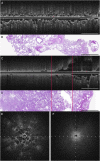Toward the guidance of transbronchial biopsy: identifying pulmonary nodules with optical coherence tomography
- PMID: 23828441
- PMCID: PMC3787917
- DOI: 10.1378/chest.13-0534
Toward the guidance of transbronchial biopsy: identifying pulmonary nodules with optical coherence tomography
Erratum in
-
Correction to text in: Toward the Guidance of Transbronchial Biopsy: Identifying Pulmonary Nodules With Optical Coherence Tomography.Chest. 2019 Dec;156(6):1283. doi: 10.1016/j.chest.2019.10.010. Chest. 2019. PMID: 31812207 Free PMC article. No abstract available.
Abstract
Background: Solitary pulmonary nodules (SPNs) frequently require transbronchial needle aspiration (TBNA) or biopsy to determine malignant potential, but have variable diagnostic yields. Confirming needle placement within SPNs during TBNA could significantly increase diagnostic yield. Optical coherence tomography (OCT) provides nondestructive, high-resolution, microstructural imaging with potential to distinguish SPN from parenchyma. We have developed needle-based OCT probes compatible with TBNA. Before OCT can play any significant role in guiding clinical TBNA, OCT interpretation criteria for differentiating SPN from lung parenchyma must be developed and validated.
Methods: OCT of SPN and parenchyma was performed on 111 ex vivo resection specimens. OCT criteria for parenchyma and SPN were developed and validated in a blinded assessment. Six blinded readers (two pulmonologists, two pathologists, and two OCT experts) were trained on imaging criteria in a 15-min training session prior to interpreting the validation data set.
Results: OCT of lung parenchyma displayed evenly spaced signal-void alveolar spaces, signal-intense backreflections at tissue-air interfaces, or both. SPNs lacked both of these imaging features. Independent validation of OCT criteria by the six blinded readers demonstrated sensitivity and specificity of 95.4% and 98.2%, respectively.
Conclusions: We have developed and validated OCT criteria for lung parenchyma and SPN with sensitivity and specificity > 95% in this ex vivo study. We anticipate that OCT could be a useful complementary imaging modality to confirm needle placement during TBNA to potentially increase diagnostic yield.
Figures


Similar articles
-
Needle-based Optical Coherence Tomography to Guide Transbronchial Lymph Node Biopsy.J Bronchology Interv Pulmonol. 2018 Jul;25(3):189-197. doi: 10.1097/LBR.0000000000000491. J Bronchology Interv Pulmonol. 2018. PMID: 29659420 Free PMC article.
-
Flexible needle with integrated optical coherence tomography probe for imaging during transbronchial tissue aspiration.J Biomed Opt. 2017 Oct;22(10):1-5. doi: 10.1117/1.JBO.22.10.106002. J Biomed Opt. 2017. PMID: 29022301
-
Diagnosing lung carcinomas with optical coherence tomography.Ann Am Thorac Soc. 2015 Feb;12(2):193-201. doi: 10.1513/AnnalsATS.201408-370OC. Ann Am Thorac Soc. 2015. PMID: 25562183 Free PMC article.
-
Transbronchial needle aspiration. An underused diagnostic technique.Clin Chest Med. 1999 Mar;20(1):39-51. doi: 10.1016/s0272-5231(05)70125-8. Clin Chest Med. 1999. PMID: 10205716 Review.
-
Transbronchial needle aspiration of central and peripheral nodules.Monaldi Arch Chest Dis. 2001 Oct;56(5):436-45. Monaldi Arch Chest Dis. 2001. PMID: 11887502 Review.
Cited by
-
Advances in early detection of non-small cell lung cancer: A comprehensive review.Cancer Med. 2024 Sep;13(18):e70156. doi: 10.1002/cam4.70156. Cancer Med. 2024. PMID: 39300939 Free PMC article. Review.
-
Nano-optic endoscope for high-resolution optical coherence tomography in vivo.Nat Photonics. 2018 Sep;12(9):540-547. doi: 10.1038/s41566-018-0224-2. Epub 2018 Jul 30. Nat Photonics. 2018. PMID: 30713581 Free PMC article.
-
Diagnostic modalities in the mediastinum and the role of bronchoscopy in mediastinal assessment: a narrative review.Mediastinum. 2024 Dec 6;8:51. doi: 10.21037/med-24-32. eCollection 2024. Mediastinum. 2024. PMID: 39781205 Free PMC article. Review.
-
Distinguishing Tumor from Associated Fibrosis to Increase Diagnostic Biopsy Yield with Polarization-Sensitive Optical Coherence Tomography.Clin Cancer Res. 2019 Sep 1;25(17):5242-5249. doi: 10.1158/1078-0432.CCR-19-0566. Epub 2019 Jun 7. Clin Cancer Res. 2019. PMID: 31175092 Free PMC article.
-
Needle-based Optical Coherence Tomography to Guide Transbronchial Lymph Node Biopsy.J Bronchology Interv Pulmonol. 2018 Jul;25(3):189-197. doi: 10.1097/LBR.0000000000000491. J Bronchology Interv Pulmonol. 2018. PMID: 29659420 Free PMC article.
References
-
- Gould MK, Fletcher J, Iannettoni MD, et al. Evaluation of patients with pulmonary nodules: when is it lung cancer? ACCP evidence-based clinical practice guidelines (2nd ed). Chest. 2007;132(suppl 3):108S-130S - PubMed
-
- Baaklini WA, Reinoso MA, Gorin AB, Sharafkaneh A, Manian P. Diagnostic yield of fiberoptic bronchoscopy in evaluating solitary pulmonary nodules. Chest. 2000;117(4):1049-1054 - PubMed
-
- Rivera MP, Mehta AC. Initial diagnosis of lung cancer: ACCP evidence-based clinical practice guidelines (2nd edition). Chest. 2007;132(suppl 3):131S-148S - PubMed
-
- Mazzone P, Jain P, Arroliga AC, Matthay RA. Bronchoscopy and needle biopsy techniques for diagnosis and staging of lung cancer. Clin Chest Med. 2002;23(1):137-158 - PubMed
Publication types
MeSH terms
Grants and funding
LinkOut - more resources
Full Text Sources
Other Literature Sources
Miscellaneous

